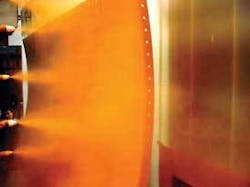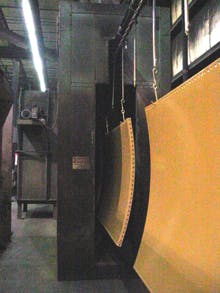Tanks & Structures: Coatings Protection against Tank Corrosion Translates into Longer Lifespan
by Peter Vodak
If you’re considering purchase of a new liquid storage tank, the coating type found on the inside will be one of the most important factors you consider. Whether you plan to store potable water, wastewater, chemicals or other liquids, each material has its own specific requirements.
Quality coatings are essential. They provide corrosion and abrasion resistance, protecting the inside of the tank from materials that pass through and extending its life. For liquid tanks, they also provide chemical resistance. Finally, they mean less maintenance during the tank’s life.
Construction materials used for tanks and silos are basically defined - carbon steel, stainless steel, aluminum and, for exceptionally large volume, concrete. What most differentiates brands and manufacturers (and the quality and total lifecycle of the tank) is the coating. Some examples of coatings include epoxy (such as Trico Bond EPTM), glass fused-to-steel (such as VitriumTM), high heat coatings, cold weather coatings and coatings designed to withstand high levels of acidity.
Epoxy coatings are most commonly applied electrostatically either as powder or liquid. Once applied and cured, epoxy coatings will bend without breaking or tearing. On the exterior, epoxy coatings may be combined with urethane topcoats to provide protection against environmental elements.
Robust Protection
When it comes to liquid storage, consider two important factors: corrosion and chemical resistance. In general, stored liquids are more aggressive toward tanks than dry products. Choose a coating that’s specifically designed for liquids that offers proven corrosion resistance over long periods of time. For liquid chemical storage, choose a coating that’s designed to withstand the aggressive effects of products such as strong acids and bases.
The Safety Factor
Coatings do play a role in safety. Some coatings are designed for storing a wide variety of products. When it comes to safety, the most important consideration is making sure the tank coating is suitable for the application. Coatings are application specific, so if the tank you need is for liquid storage, be sure the coating applied is for liquid. Some coatings may react poorly with certain products.
It’s unsafe to use an old storage tank for a product for which it wasn’t designed and tested. If you’re considering recycling a used tank for storing a new product (such as using a dry material storage tank for liquids, or a water storage tank for liquid chemicals), be sure to first have the tank evaluated for safety, flow, corrosion resistance, chemical resistance, etc. Incorrect use of a tank could result in severe corrosion, premature failure of the coating, harm to the product or serious injury to personnel. Also keep in mind that, if you plan to use a tank for drinking water storage, the tank must be NSF-certified.
Application Issues
The key difference in coatings lies in the application process. The highest quality coatings are applied at the factory under environmentally controlled circumstances to ensure the most consistent application. Taken a step further, the best coatings are also thermally cured at the factory. Some manufacturers apply the coatings at the factory, but then allow them to air-dry and cure with ambient heat, which exposes the cure to environmental factors such as dust and humidity. Other manufacturers outsource the coating process. The optimal coating solution is one that’s both applied and thermally cured under controlled factory conditions before the tank is shipped and erected in the field. High quality bolted and factory welded tanks offer this feature.
Field-welded and concrete tanks often receive their coatings onsite in the field once the tank has been erected. These tanks may need to undergo a chemical process to protect the coating while the tank is being erected (i.e., heat from welding may damage the coating). If you’re reviewing this type of tank, make sure there are adequate quality controls measures listed in the specification, and consider third party inspections. Be aware, once a tank has been erected in the field, there are often areas of the tank that are extremely difficult to sand blast and/or fully prepare for field coating. Even “missing the smallest spots” leaves exposed areas open to corrosion. Also, the thickness of coatings applied in the field cannot be controlled as closely as it can under factory conditions, which may result in uneven application. Finally, weather and the environment - dust, humidity, temperature and wind - will affect field curing processes.
Other Considerations
Would you ever consider moving your tank? Coatings applied in the field reduce the ability to move the tank, as the coating will tear or break when the pieces are moved. Also, if your product has special requirements, ask manufacturers about special coatings available that resist high heat, are suited for cold weather or withstand acidity.
Total Cost Review
If a tank manufacturer promises a low cost for tank and coating, make sure the competitive products you’re comparing are equal over the total lifecycle of the tank. A higher quality coating may have a higher upfront cost but lower life maintenance and recoating requirements. A high quality coating ensures against corrosion, a common problem that shortens the life of a tank. A good quality coating often means lower maintenance.
Experienced Vendors
It may seem like common knowledge to mention experience as a factor for choosing a tank and coating, but it’s a key consideration. Consider the experience of the tank manufacturer - how long the company has been fabricating tanks, whether they use state-of-the-art coatings, whether their coatings are factory-applied and thermally cured, what are their quality control measures, what’s their sales volume, in what countries, and into which markets. Also consider tank manufacturers with third party accreditation, such as the ISO 9001 Quality Certification.
About the Author: A NACE Certified Coating Inspector, Peter Vodak is corporate coating engineer with CST Industries Inc. Columbian TecTank, a CST division, specializes in design, fabrication, factory coating/thermally curing and erection of tanks for liquid and dry bulk storage. They’re manufactured at ISO 9001 Certified facilities and found in 123 countries. Contact: 815-756-1551, [email protected] or www.columbiantectank.com



